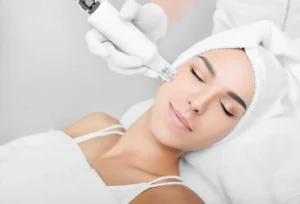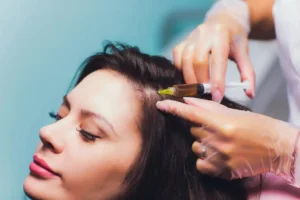
PDO threads are gaining traction as a favored method for non-surgical facelifts. They provide a less invasive option compared to traditional surgical facelifts, offering a way to rejuvenate the face without a lengthy recovery time. Many individuals seeking to lift and tighten their skin find PDO threads to be a compelling choice due to their ability to enhance facial contours and improve overall skin appearance. This method is particularly appealing for those looking to address signs of aging while avoiding more invasive procedures. With minimal downtime and noticeable results, PDO threads are becoming a go-to solution for achieving a refreshed and youthful look.
What Are PDO Threads?
PDO threads are a type of medical suture made from polydioxanone, a synthetic material that is absorbable and has been used safely in surgery for many years.
Originally employed for wound closure, these threads have found a new application in aesthetic treatments. PDO threads, including smooth and barbed, come in various forms to cater to different cosmetic needs. Smooth threads are typically used to enhance skin texture and stimulate collagen production. In contrast, barbed threads are designed to provide a lifting effect by anchoring into the skin and repositioning sagging tissues.
These threads are biocompatible, meaning the body can absorb them over time without causing adverse reactions. Their versatility allows them to be used in multiple areas of the face, such as the cheeks, jawline, and neck, making them a popular choice for non-surgical facial rejuvenation.
How PDO Threads Work
When inserted into the skin, these threads act like a scaffold, lifting and supporting sagging tissues. This initial lift is due to the physical properties of the threads themselves, which are strategically placed to anchor the skin in a more youthful position.
The second, and perhaps more significant, aspect of how PDO threads work is their ability to stimulate collagen production. Collagen is a protein that sustains structure and elasticity to the skin. As the PDO threads gradually dissolve over several months, they trigger a localized inflammatory response that promotes the synthesis of new collagen fibers. This procedure enhances the skin’s general firmness and texture in addition to helping to preserve the lifting effect.
The insertion of PDO threads can be done using various techniques, such as the straight-line technique for fine lines, the mesh technique for broad areas of sagging, or the spiral technique for specific lifting in areas like the mid-face and jowls. Each technique has its own specific application, allowing for a highly customizable treatment tailored to the patient’s needs and desired outcomes.
As the threads are absorbed, they leave behind a framework of new collagen that continues to support the skin, extending the treatment’s benefits. This dual action of mechanical lift and collagen stimulation makes PDO threads a practical and versatile option for non-surgical facial rejuvenation, offering results that can last up to 18 months.
Procedure Details
Before the procedure begins, a thorough consultation is conducted to assess the patient’s skin condition and discuss their aesthetic goals.
On the day of the procedure, the treatment area is first cleaned and prepped. A topical anesthetic or local anesthesia is applied to minimize discomfort during the insertion of the threads. Once the area is numbed, the practitioner uses a fine needle or cannula to insert the PDO threads into the deeper layers of the skin. The number of threads and their placement will vary depending on the desired outcome and the specific areas being treated.
The procedure itself typically takes about 30 to 60 minutes, depending on the extent of the treatment. During the insertion, patients may feel some pressure or slight pulling, but significant pain is generally avoided due to the anesthesia.
After the threads are inserted and positioned correctly, the practitioner gently smooths the skin and checks the results to ensure even lifting and contouring. Any necessary adjustments are made at this stage to achieve a balanced and natural look.
Post-Treatment
Post-procedure, patients might experience some mild swelling, bruising, or redness at the insertion sites. These side effects are usually temporary and subside within a few days. Most individuals are able to resume their regular activities right away following the surgery.
Appointments for follow-up may be made in order to track the process of recovery and evaluate the outcomes. The full effects of the procedure, including improved skin texture and lifting, typically become more noticeable as the threads stimulate collagen production over the following weeks and months.
Before and After Treatment Care
Proper preparation and aftercare are crucial for optimizing the results and ensuring a smooth recovery from a PDO thread procedure.
Before Treatment Care
- Avoid Blood-Thinning Medications and Supplements: Refrain from taking aspirin, ibuprofen, NSAIDs, and supplements like ginkgo biloba and fish oil for a week before the procedure to reduce the risk of bruising and bleeding.
- Limit Alcohol and Smoking: Avoid alcohol and smoking for at least 48 hours before treatment to prevent blood thinning and impaired healing.
- Stay Hydrated and Maintain Good Nutrition: For assistance in your body’s healing process, get plenty of rest and consume a well-balanced diet high in vitamins and minerals.
- Provide a Comprehensive Medical History: Share your complete medical history, including medications, allergies, and past procedures, with your practitioner to tailor the treatment to your needs and ensure safety.
After Treatment Care
- Follow Skincare Advice: Adhere to your practitioner’s recommended skincare regimen, which typically includes gentle cleansing and moisturizing, avoiding harsh products.
- Avoid Strenuous Activities: Avoid strenuous exercise and heavy lifting for at least 48 hours after the procedure to prevent disruption of the threads and ensure proper healing.
- Sleep on Your Back with Elevated Head: For the first few nights, sleep on your back with your head elevated to reduce swelling and avoid pressure on the treated areas.
- Protect from Sun Exposure: Use a high SPF sunscreen and wear a wide-brimmed hat to protect your skin from UV exposure, which can affect healing and results.
- Avoid Facial Manipulation: For at least two weeks, avoid massaging or excessively moving your face, as well as facial treatments and dental work.
Takeaway
Are you prepared to have a non-surgical facelift to revitalize your appearance? Book an appointment with 360Envy Aesthetics & Wellness right now to learn more about the life-changing potential of PDO thread treatments. Our skilled staff is committed to assisting you in achieving a young, renewed appearance with the least amount of downtime. Contact us right now to begin your path to a more self-assured you!







